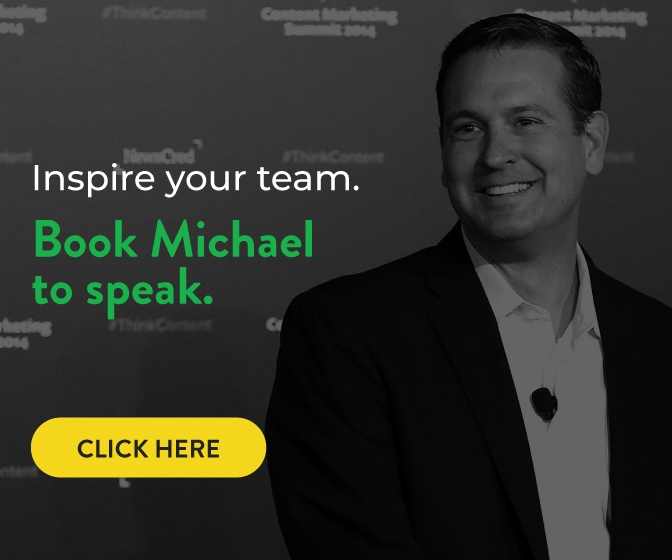As someone who does content marketing for a living, AdAge is practically required reading. As I sat down to leaf through the articles one August afternoon in 2016, something unusual caught my eye.
An article – in the marketing industry’s bible – that questioned the validity of excessive marketing. A wake-up call that made me realize that above anything else, empathy is essential for effective marketing in the coming decade.
It was an argument that I’ve been making for some time. To see it in this legacy advertising industry publication, though, took me aback. I had to read more.
That article was Jack Neff’s superb “Are Brands Optimizing Their Marketing to Death?” As I read, I found myself nodding in agreement as I realized that here was someone – in the marketing and advertising industry, no less – that saw the same trends that I did.
His insights inspired part of a chapter in my latest book, Mean People Suck. That chapter, “Our Customers Know We Suck,” speaks to marketers’ tendency to solve revenue and website traffic challenges with – you guessed it – more marketing campaigns.
Quick Takeaways:
- More campaigns don’t always mean more success, especially if you repeat the same message.
- Be sensitive to your customers’ time, needs, and attention span.
- Create content that is useful to your target customers – content that solves the kinds of problems that keep them up at night.
- Keep your customers at the center of your story.
Marketing Overload Drives ROI Down
In reality, as Neff points out, the “more campaigns” strategy looks to be as dated as the slick cigarette ads of the 1960s. And – like cigarettes – too many of the same ads can cause an early demise for companies that insist on running them.
Procter & Gamble, for instance, discovered that when they cut back on some of their targeted Facebook ads, they experienced a surprising outcome: their sales increased. One of the reasons, Neff points out, appears in a recent Advertising Research Foundation study. That study revealed that if someone sees a digital banner ad over 40 times in a month, sales begin to drop. In fact, as a Key Media Solutions post pointed out, after only ten views of an ad, they become annoyed – even angry.
Who in their right mind thinks running annoying ads is a good idea? Apparently, plenty of brands.
- Even though 200 million-plus people are paying good money for adblockers to stop these ads
- Even though as far back as 2016, Forbes reported that consumers reject brands that bombard them with annoying or irrelevant content
- Even though digital marketing gurus like Neil Patel reveal that 61 percent of consumers are influenced by custom content that helps them live better lives and make more money
Why? Perhaps it’s because no one inside these brands – with the notable exception of Procter & Gamble and others that have escaped the bureaucratic matrix – dares to tell the emperor that he’s buck naked.
The Hard Truth: Customers Want Brands that Listen
When companies step outside of their bureaucratic mindset and embrace a more collaborative, agile view of how to do business, they leapfrog over the legacy brands that drag their feet to the ad agencies year after year.
As Stanford’s Nilofer Merchant put it, “…to consider new ideas, you have to be willing to let go of ones that no longer serve you.”
Bingo.
I’d take that one step further. In that process of collaboration that Merchant rightly advocates comes the need to listen to others’ perspectives. The more that collaborators put themselves in each other’s shoes – and their customers’ – the more effective collaboration will be.
In a word, empathy.
Marketing Needs to Step into Their Customers’ Shoes
When you put yourself – and your marketing team – in your customers’ shoes, you’ll look at those statistics and run as far away as you can go from those ad agencies. You’ll do the research yourself (or outsource the research to a like-minded agency) and find out who your customers are. You’ll learn what keeps them up at night.
And, after you’ve learned the answers to those questions, you’ll create content that speaks to them. Content that soothes their three-o’clock-in-the-morning woes.
Contrast that with Coca-Cola’s misstep a few years ago. Instead of replacing their chief marketing officer (CMO), they eliminated the role altogether, replacing it with that of a “chief growth officer” (CGO).
Talk about navel-gazing. Instead of a customer-focused role (marketing, after all, involves outreach), they focused on a company-focused role (growth – about as self-serving as it gets).
The CGO fulfilled his role to a T. At least, at first. In announcing the new role, Coke’s then-CMO stated the philosophy that led to this change, “If you want people to love to drink Coca-Cola, please show in your commercial people who love drinking Coca-Cola…”
His mocking tone in criticizing the brand’s former tone wasn’t lost on E.J Schultz, the AdAge writer who reported on the change. Gwynn pointed out that the CGO role’s new direction veered off its old “Open Happiness” tagline to “re-Coca-Coliz[e]” the drink. Whereas the previous content iteration emphasized a customer benefit – happiness – the new philosophy and related content would be variations on the product-centric theme.
It didn’t last long. In December 2019, Simon Gwynn reported in PR Week, the beverage giant retreated to its previous structure, tapping Manolo Arroyo to assume the recreated CMO role.
In fact, even during the tenure of the CGO, Francisco Crespo, the company discovered that it needed to tap into customer benefits.
Coke’s superb Ramadan ad, portraying the beverage as the perfect drink to quench the thirst that built up over hours of going without eating or drinking, demonstrated that customer benefits – the “Open Happiness” vibe – won the day after all.
The beverage giant, as it did back in the 1980s with “New Coke” – another bad management decision – overcame its misstep with the power of empathy.
Open Your Customers’ Happiness with Customer-Centric Marketing
Your company, too, can take the lead in its industry when it implements a more customer-centric approach to marketing.
As branding expert Derrick Rozdeba points out, on any given day, your customers are “bombarded with over 5,000 brand messages.” Of that 5,000, Rozdeba notes, only 12 get customers’ attention.
You can overcome that saturation with content that gets their attention from the first sentence to the final paragraph. “How?” you ask.
Rozdeba put it well: “Put our branding feet into the consumer’s shoes for a day.” When you streamline your customer journey by putting customers’ needs at the forefront of your messaging, you get their attention.
Empathetic Marketing Extends to Criticism as Well
That messaging needs to extend into your replies to criticism as well. Though unkind comments might sting at first, they often are opportunities to make a difference – and a customer for life – depending on your response.
Use their feedback as a springboard for change. Reframe it as target customer research, and you can see negative comments as your chance to win these customers back. Who knows? If your response meets their needs, you might even get some referrals out of your efforts.
When you take marketing out of its silo and realize that it often spills over into customer service and research, your messages will be among the 12 that people notice. Now, that’s leveraging the power of empathy to make your marketing more effective.
So what do you think? Please consider picking up your copy of Mean People Suck today, and get the bonus visual companion guide as well. Or check out our services to help evolve your culture. I would be thrilled to come present to your team on the power of empathy!


Your article helped me a lot, is there any more related content? Thanks!
Hello just wanted to give you a quick heads up. The words in your content seem to be
running off the screen in Chrome. I’m not sure if this is a formatting issue or something
to do with internet browser compatibility but I figured I’d post to let you know.
The design look great though! Hope you get the problem fixed soon. Cheers
Feel free to surf to my homepage … nordvpn coupons inspiresensation (http://t.co/a8rl5sR487)
Wow, superb blog layout! How long have you been blogging for?
you made blogging look easy. The overall look of your site is excellent, as well as
the content!
Here is my page … nordvpn coupons inspiresensation
Do you have a spam issue on this website; I also am a blogger, and I was curious about your situation; we have created
some nice procedures and we are looking to exchange methods with
other folks, please shoot me an email if interested.
my blog post – nordvpn coupons inspiresensation
Great beat ! I wish to apprentice while you amend your site, how could i subscribe for a
blog website? The account helped me a acceptable deal.
I had been tiny bit acquainted of this your broadcast offered bright clear idea
my homepage … nordvpn coupons inspiresensation (shorter.me)
350fairfax nordvpn
It’s going to be ending of mine day, but before ending I am reading this
great piece of writing to increase my knowledge.
Feel free to surf to my web blog … nord vpn promo
Your article helped me a lot, is there any more related content? Thanks!